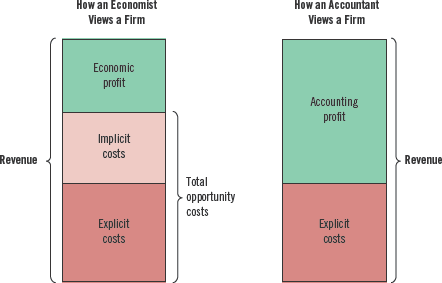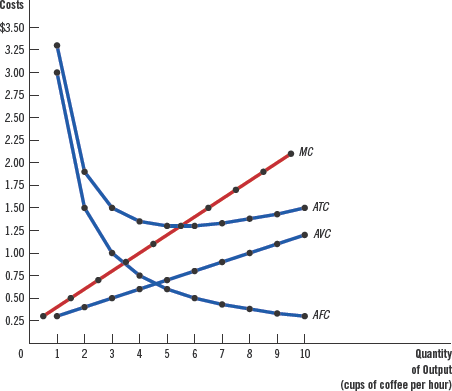14 - The Costs of Production#
Industrial organization is the study of how firms’ decisions about prices and quantities depend on the market conditions they face.
14.1 - What Are Costs?#
Total Revenue, Total Cost, and Profit#
Total revenue is the amount that a firm receives from the sale of its output.
Total cost is the market value of the inputs a firm uses in production.
Profit is the total revenue minus total cost.
Explicit costs are input costs that require an outlay of money by the firm.
Implicit costs are input costs that do not require an outlay of money by the firm.
Economists and Accountants Measure Profit Differently#
An implicit cost that every business faces is the opportunity cost of financial capital. This cost is recognized by economists, but not accountants, since no money flows from this amount.
Economic profit is total revenue minus total cost, including both implicit and explicit costs.
Accounting profit is total revenue minus total explicit cost.

14.2 - Production and Costs#
The production function is the relationship between the quantity of inputs used to make a good and the quantity of output of that good.
The marginal product of any input in the production process is the increase in output that arises from an additional unit of input. The property whereby the marginal product of an input declines as the quantity of the input increases is called the diminishing marginal product.
A graph which plots quantity produced on the \(x\)-axis and total cost on the \(y\)-axis is called the total cost curve.
14.3 - The Many Measures of Cost#
Fixed and Variable Costs#
Total costs can be divided into two categories:
Fixed costs are costs that do not vary with the quantity of output produced.
Variable costs are costs vary with the quantity of output produced.
Average and Marginal Cost#
Average total cost is the total cost divided by the quantity of output.
It follows that the average fixed cost is the fixed cost divided by the quantity of output, and the average variable cost is the variable cost divided by the quantity of output.
The marginal cost is the increase in total cost that arises from an extra unit of production.
Average cost tells us the cost of a typical unit of output if total cost is divided evenly over all the units produced. Marginal cost tells us the increase in total cost that arises from an additional unit of output.
Cost Curves and Their Shapes#

The efficient scale of a firm is the quantity of output that minimizes average total cost.
Whenever marginal cost is less than average cost, average total cost is falling. Whenever marginal cost is greater than average total cost, average total cost is rising.
The marginal-cost curve crosses the average-total-cost curve at its minimum.
14.4 - Costs in the Short Run and the Long Run#
The Relationship between Short-Run and Long-Run Average Total Cost#
Many decisions are fixed in the short run but variable in the long run.
Economies and Diseconomies of Scale#
When long-run average total cost declines as output increases, there are said to be economies of scale. When the opposite occurs and long-run average total cost rises as output increases, there are disceconomies of scale. When long-run average total cost does not vary with the level of output, there are constant returns to scale.
Economies of scale often arise because higher production levels allow specialization among workers, which enables them to be better at certain tasks.
Diseconomies of scale often arise because of coordination problems that occur in large organizations.
